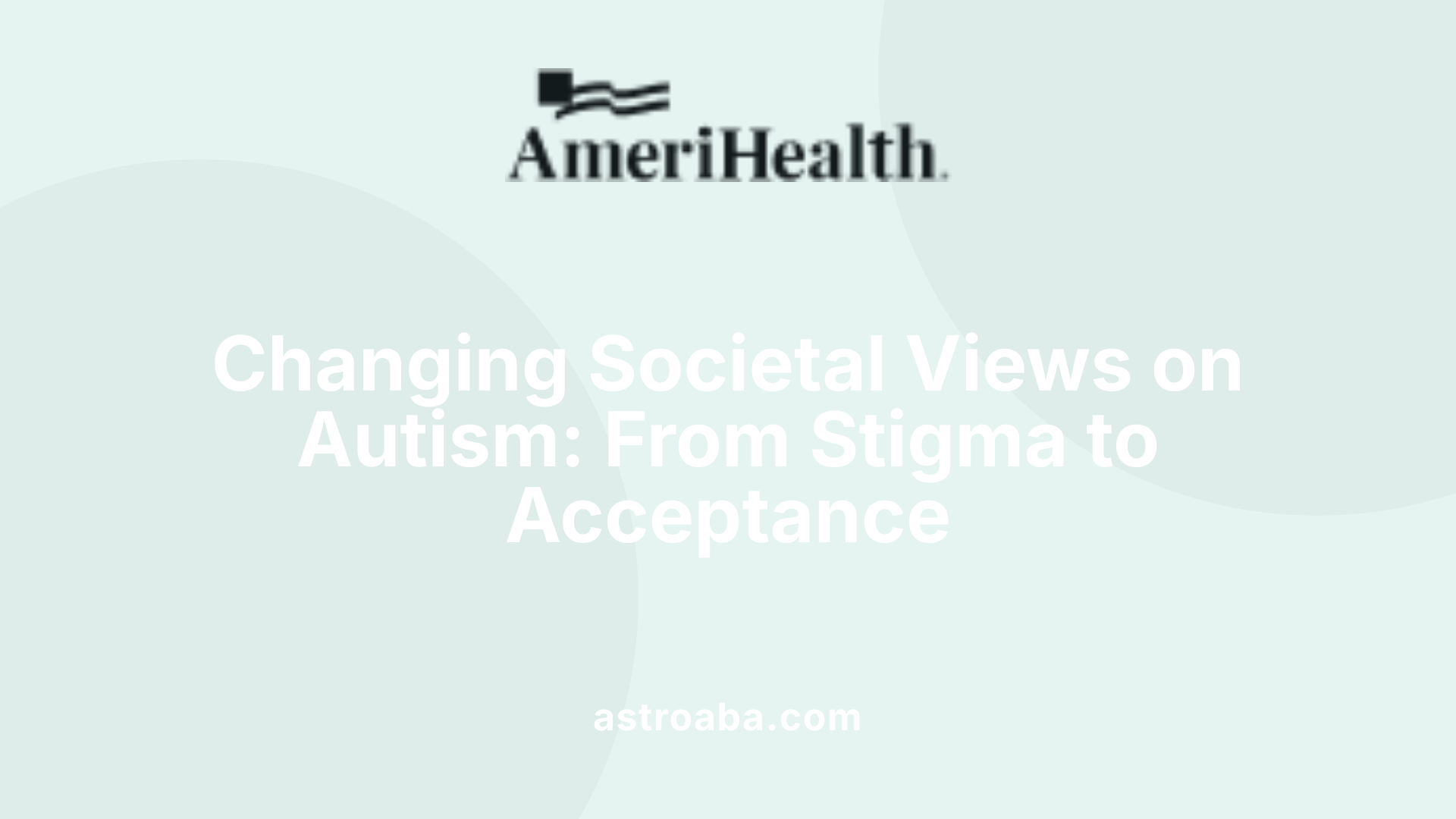Who Made Autism?
Uncovering the Origins of Autism’s Understanding

Tracing the Path from Early Observations to Modern Interpretations
The history of autism is a rich tapestry woven from pioneering research, evolving terminology, and societal perceptions. From initial descriptions by early psychiatrists to its recognition as a spectrum condition in contemporary diagnostics, understanding who shaped autism's conceptual landscape reveals much about our scientific and cultural developments. This article chronicles the key figures, landmark studies, shifting classifications, and societal beliefs that have collectively defined autism today.
Early Concepts and the Introduction of 'Autism'

What are the historical origins and development of autism?
The idea of autism has complex roots and has evolved significantly since the early 20th century. The term "autism" first appeared in 1911 through the work of Swiss psychiatrist Eugen Bleuler, who used it in his description of schizophrenia. Bleuler observed that some patients with schizophrenia exhibited symptoms of withdrawal from reality and difficulties in communication, which he termed "autism" to reflect a withdrawal into one's inner world.
Initially, autism was associated with severe mental illnesses like schizophrenia, and it was primarily used to describe patients with a marked social withdrawal and communication challenges within this disorder. It was only later that researchers began to see autism as a distinct developmental condition.
The shift toward understanding autism as a separate disorder began with pioneering research in the 1930s and 1940s. In 1943, American psychiatrist Leo Kanner published his seminal paper on "Early Infantile Autism," describing a unique syndrome characterized by social difficulties, insistence on routines, and sensory sensitivities. Around the same time, Hans Asperger studied children with similar social challenges but with their own distinct features, leading to the characterization of what is now called Asperger syndrome.
The initial descriptions of autism laid the groundwork for further research and reclassification. By the 1960s, as understanding grew and misconceptions about causes, such as the discredited 'refrigerator mother' theory, were challenged, autism was recognized more broadly as a neurodevelopmental disorder. Over subsequent decades, diagnostic manuals like the DSM incorporated autism, refining criteria and understanding.
Today, autism is viewed as a spectrum, reflecting wide variations in traits and severity, and it is no longer solely associated with childhood schizophrenia but recognized for its unique developmental profile.
Who was the first person to describe autism as a distinct condition, and when did this occur?
Leo Kanner is widely credited with being the first to describe autism as a clearly defined, distinct condition in 1943. His detailed observations of children with characteristics such as social withdrawal, insistence on sameness, repetitive behaviors, and sensory sensitivities marked a significant turning point in the understanding of autism.
Kanner's work helped differentiate autism from other mental health issues and set the stage for future research and diagnostic development.
Gruniya Sukhareva's Pioneering Work in the 1920s
 In the landscape of autism research, Gruniya Sukhareva emerges as a groundbreaking figure whose early observations laid important groundwork. In 1924, Sukhareva observed a boy exhibiting traits that would later be recognized as part of the autism spectrum during an evaluation at a Moscow clinic. Building on these initial insights, she identified five more boys with similar behavioral patterns.
In the landscape of autism research, Gruniya Sukhareva emerges as a groundbreaking figure whose early observations laid important groundwork. In 1924, Sukhareva observed a boy exhibiting traits that would later be recognized as part of the autism spectrum during an evaluation at a Moscow clinic. Building on these initial insights, she identified five more boys with similar behavioral patterns.
Her detailed descriptions, published in her 1925 paper, closely align with modern diagnostic criteria for autism. She characterized these children by features such as social withdrawal, a preference for their internal worlds, and peculiarities or extraordinary talents. Her observations extended to affective expression, noting a "flattened affective life" and a "lack of facial expressiveness." She described behaviors like stereotypic talking, where children would repeat phrases or sounds, and an intense focus on specific interests, often pursued in an isolated manner.
Sukhareva’s work was pioneering in that it moved beyond the common attribution of these behaviors to psychological or parenting issues prevalent at the time. She laid the foundation for understanding autism as a neurological and developmental condition.
Her assessments incorporated detailed behavioral observations and familial patterns, indicating a thorough investigative approach. Despite the significance of her findings, her work was initially published in German in 1926 and later translated into English in 1996, which delayed broader recognition.
Her contributions are highly respected in Russia, where she authored over 150 papers and several textbooks on autism and related topics. Sukhareva’s research was instrumental in shifting the perception of autism from a psychological anomaly to a neurological condition, influencing subsequent research and diagnostic practices.
| Key Characteristics Described by Sukhareva | Behavioral Traits | Context and Implications |
|---|---|---|
| Social withdrawal | Preference for solitude | Early recognition of social challenges |
| Stereotypic talking | Repetitive speech | Indicative of communication patterns |
| Intense, focused interests | Narrow areas of fascination | Demonstrates deep, specific interests |
| Flattened affect | Limited facial expressiveness | Altered emotional responsiveness |
Her pioneering research set the stage for later discoveries by Kanner and Asperger, establishing foundational insights into autism’s neurological basis. Her work underscores how early scientific observations can profoundly influence understanding and diagnosis of complex conditions.
Hans Asperger and the Asperger Syndrome
 Hans Asperger's work in 1944 was crucial in identifying a subgroup of children with distinctive behavioral patterns that would later be recognized as Asperger syndrome. Asperger observed children who displayed social difficulties similar to those seen in autism but with notable differences.
Hans Asperger's work in 1944 was crucial in identifying a subgroup of children with distinctive behavioral patterns that would later be recognized as Asperger syndrome. Asperger observed children who displayed social difficulties similar to those seen in autism but with notable differences.
He described children exhibiting typical or even advanced speech abilities alongside social challenges. These children often had narrow interests and could be socially awkward, but they did not demonstrate the severe communication and cognitive impairments typical of early autism. Asperger also noted that these children often showed clumsiness and motor coordination issues.
This profile diverged from Leo Kanner’s earlier descriptions of autism, which emphasized profound social withdrawal and developmental delays. While Kanner’s children were often non-verbal or minimally verbal, Asperger's subjects generally had fluent speech and normal or above-average intelligence.
The recognition of these differences helped expand the understanding of the autism spectrum. Asperger syndrome, named after him, became an important concept, highlighting the wide range of neurodiverse presentations.
It wasn't until the 1980s that Asperger's work gained widespread attention through the efforts of Lorna Wing, who used the term 'Asperger syndrome' in her research. The syndrome was officially included in DSM-IV in 1994, emphasizing high-functioning autism characterized by social difficulties and specific interests.
In summary, Asperger’s description of children with high-functioning features broadened the scope of autism research. It challenged earlier notions of autism as a uniform disorder and underscored the spectrum’s diversity. This understanding has greatly influenced educational strategies, clinical diagnosis, and acceptance of neurodiversity today.
The Role of Leo Kanner in Defining Autism
In 1943, psychiatrist Leo Kanner published a groundbreaking paper that marked one of the first scientific descriptions of what we now recognize as autism. His work focused on a group of 11 children who displayed distinctive behaviors that set them apart from other groups of childhood neurological conditions.
Kanner’s detailed observations identified core symptoms such as severe difficulties in social interactions, insistence on routines and sameness, and particular communication challenges, including echolalia and atypical speech patterns. These features highlighted a new, recognizable syndrome, which he termed 'early infantile autism.' At the time, these behaviors were often misunderstood and incorrectly attributed to psychological causes, but Kanner's work laid the foundation for understanding autism as a distinct neurological condition.
Autism's journey into clinical classification formally began with its first appearance in the DSM (Diagnostic and Statistical Manual of Mental Disorders) in 1980. Prior to this, the concept originated from Kanner’s pioneering description, but it was not officially recognized as a standalone diagnosis. The DSM-III categorized autism as part of Pervasive Developmental Disorders (PDD), with specific criteria to diagnose infantile autism.
Over subsequent editions, the classification of autism expanded and evolved. The DSM-III-R introduced the term 'autistic disorder' to further specify the diagnosis. Later, the DSM-IV broadened the scope, recognizing a spectrum of related disorders such as Asperger’s Disorder and PDD-NOS, reflecting researchers' growing understanding of autism’s heterogeneity.
In 2013, the DSM-5 made a significant change by consolidating these various diagnoses into a single category called Autism Spectrum Disorder (ASD). This move adopted a more dimensional perspective that considers the severity and range of symptoms and traits, rather than distinct subcategories. Such progression in diagnosis emphasizes autism's diverse presentations and recognizes it as a spectrum rather than a single, narrow condition.
Through this evolution, Kanner's initial description has remained central, inspiring ongoing research and refinement of autism understanding. His work transformed perspectives from flawed theories blaming parenting to neuroscience-based insights, paving the way for contemporary diagnosis and support.
Societal Perceptions and Shifts in Understanding Autism

How has the terminology and conceptual understanding of autism evolved over time?
The way society understands and describes autism has changed dramatically over the decades. Early on, autism was thought to be a rare mental disorder or a form of schizophrenia. Psychiatrists like Eugen Bleuler first used the term in 1908 to describe withdrawal in schizophrenic patients. Later, in the 1940s, Leo Kanner and Hans Asperger identified behaviors in children that would come to define autism, but the labels and ideas remained tightly linked to psychological and psychiatric models.
Throughout the late 20th century, the language shifted from 'infantile autism' and 'autistic disturbance' to more inclusive and respectful terms. The Diagnostic and Statistical Manual of Mental Disorders (DSM) incorporated autism as a diagnosis in 1980, emphasizing it as a developmental disorder rather than a psychotic one.
The most recent change came with DSM-5 in 2013, which merged previous subcategories like Asperger syndrome into a single diagnosis called Autism Spectrum Disorder (ASD). This change reflected a broader understanding of autism as a spectrum with a wide range of traits and severities. Today, terminology also leans toward embracing neurodiversity, with many advocating for person-first language (e.g., "a person with autism") or identity-first language (e.g., "autistic person"), emphasizing acceptance and celebrating neurological differences.
Overall, the conceptual framework has evolved from viewing autism as a disorder rooted in pathology to recognizing it as a natural variation of human neurodiversity.
Are there any useful resources to learn about the history of autism?
Yes, numerous resources are available for those interested in exploring the rich history of autism. Academic journals and books offer detailed histories, often highlighting pioneering work by figures like Sukhareva, Asperger, and Kanner.
Online timelines and educational websites provide accessible summaries of key milestones, such as the first description of autism, diagnostic developments, and societal shifts.
Further, specialized documentaries and biographies shed light on influential researchers and societal attitudes over time.
Some notable resources include:
- Scholarly articles tracing the evolution of diagnosis and perception.
- Websites dedicated to the history of autism, like those from autism research organizations.
- Books such as "In a Different Key" by John H. McCain, Jr., which explores personal and clinical histories.
These resources help contextualize how scientific understanding and society’s view of autism have developed, fostering greater awareness and acceptance.
Influence of Diagnostic Criteria and Changing Definitions

When was autism first added to the DSM, and how has its diagnostic classification evolved?
Autism was first officially included as a diagnosis in the DSM-III in 1980. Initially, it was categorized under Pervasive Developmental Disorders with specific criteria for 'Infantile Autism.' Prior to this formal recognition, the concept of autism was rooted in Leo Kanner's groundbreaking work in 1943, which detailed the core features such as challenges in social communication, insistence on routine, and sensory sensitivities. At that early stage, autism was often confused with childhood schizophrenia, but Kanner's descriptions helped distinguish it as a separate condition.
Over the years, the diagnostic classification of autism evolved significantly. The recognition of related conditions like Asperger’s syndrome and Pervasive Developmental Disorder-Not Otherwise Specified (PDD-NOS) in later DSM editions broadened the understanding of autism's heterogeneity. The DSM-IV, released in 1994, acknowledged a spectrum of these related disorders, emphasizing the diversity in presentation.
A major shift occurred with the publication of the DSM-5 in 2013. This edition consolidated previous separate diagnoses into a single umbrella term: Autism Spectrum Disorder (ASD). It moved from a strictly categorical model to a dimensional one, focusing on severity levels and associated features. This approach better reflects the wide range of abilities and challenges experienced by individuals with autism.
The transition to a spectrum model has impacted both diagnosis and treatment. It allows for a more comprehensive understanding of autism as a spectrum of conditions rather than discrete, mutually exclusive categories. This evolution in classification aligns with ongoing research emphasizing the neurodiversity perspective, recognizing autism as a natural variation in human neurology rather than a purely medical disorder.
| DSM Edition | Year | Main Change | Description |
|---|---|---|---|
| DSM-III | 1980 | Introduction | First inclusion as 'autistic disorder' with specific criteria |
| DSM-IV | 1994 | Spectrum recognition | Broader recognition of related disorders |
| DSM-5 | 2013 | Spectrum consolidation | Unified diagnosis of ASD with severity levels |
This progression underscores the shift from narrow, categorical labels toward a more inclusive, spectrum-based understanding of autism, shaping contemporary diagnosis and research.
Genetic and Environmental Factors in Autism Research
Are there any useful resources to learn about the history of autism?
Yes, a variety of resources provide detailed insights into the history of autism. Academic articles and research reviews often trace the timeline from early 20th-century work by psychiatrists like Grunya Sukhareva, who first characterized autistic traits in children in 1925, to the pioneering studies of Leo Kanner and Hans Asperger in the 1940s. These resources highlight the evolving understanding of autism—from its initial association with childhood schizophrenia to its recognition as a distinct developmental condition.
Books that focus on the history of autism explore milestones such as the introduction of the term 'autism' by Eugen Bleuler in 1911 and its later refinement within diagnostic manuals. Websites and timelines dedicated to autism history compile significant figures, discoveries, and shifts in perception, including the discrediting of harmful myths like the 'refrigerator mother' theory in the 1960s.
In addition, scholarly publications examining the transition from psychoanalytic views to neurobiological explanations offer essential context. These sources are invaluable for anyone seeking a comprehensive understanding of how scientific, clinical, and societal perspectives on autism have developed over the decades.
The Ever-Evolving Understanding of Autism
From its initial descriptions rooted in psychiatry to a complex spectrum embraced by modern neurodiversity movements, autism's history reflects scientific progress, societal change, and ongoing debates. The key figures like Sukhareva, Kanner, and Asperger laid the groundwork for recognizing autism as a neurodevelopmental condition. Over decades, diagnostic classifications have shifted from narrow, behavior-based criteria to inclusive spectrum models, fostering greater acceptance and understanding. Recognizing this journey is essential for appreciating current perspectives and supporting future advancements in research, diagnosis, and societal integration.
References
- History of autism - Wikipedia
- Autism History - News-Medical.net
- Historical Perspective - National Autism Center at May Institute
- What's in a Name? The History of Autism Spectrum Disorder
- The Diagnosis of Autism: From Kanner to DSM-III to DSM-5 and ...
- How history forgot the woman who defined autism | The Transmitter
- What causes autism? | Autism Speaks
- Autism spectrum disorder - Symptoms and causes - Mayo Clinic
- Autism | National Institute of Environmental Health Sciences
Recent articles

The Role of Prompting and Fading in ABA Therapy Programs
Enhancing Autism Interventions Through Systematic Support Reduction

The Role of ABA Therapy in Supporting Community Participation
Enhancing Lives Through Community-Focused ABA Interventions

The Role of ABA Therapy in Encouraging Initiative and Motivation
Unlocking Potential: How ABA Empowers Children to Take Initiative

How ABA Therapy Helps Children Develop Initiation and Motivation
Unlocking Potential: The Power of ABA in Fostering Child Independence

How ABA Therapy Encourages Participation in Cooperative Group Activities
Fostering Social Skills Through ABA Interventions

How ABA Therapy Supports Independent Task Initiation in Children
Empowering Children to Begin with Confidence

How ABA Therapy Helps Children Build Resilience in Challenging Situations
Building Emotional Strength Through ABA Therapy

The Impact of ABA Therapy on Reducing Anxiety in Social Settings
Transforming Social Experiences: How ABA Therapy Eases Autism-Related Anxiety

Strategies for Teaching Self-Monitoring Through ABA
Empowering Independence: Techniques to Foster Self-Monitoring with ABA

The Benefits of Combining ABA with Speech and Language Therapy
Integrating Treatment Approaches to Maximize Developmental Progress

Strategies for Teaching Cooperative Problem-Solving Through ABA
Enhancing Collaborative Skills with ABA: Proven Strategies and Techniques

How ABA Therapy Encourages Independent Participation in Daily Tasks
Empowering Autonomy: How ABA Therapy Builds Independence in Daily Life

Creating an Effective Learning Environment at Home for ABA Therapy
Building a Supportive Home Environment for ABA Success

How ABA Therapy Encourages Following Safety Rules at Home and School
Empowering Children with Autism to Follow Essential Safety Rules

How ABA Therapy Encourages Communication Using Gestures and Signs
Enhancing Social Skills with Targeted Gesture Teaching

Common ABA Therapy Techniques for Reducing Aggression
Innovative Strategies in ABA to Minimize Aggressive Behaviors

How ABA Therapy Encourages Communication Using Gestures and Signs
Unlocking the Power of Gestures and Signs in Autism Therapy

How ABA Therapy Encourages Appropriate Social Greetings
Enhancing Social Skills Through Evidence-Based Interventions

Addressing Social Anxiety Using ABA-Based Techniques
Harnessing ABA to Alleviate Social Anxiety

Famous Politicians With Autism
Celebrating Neurodiversity: Insights into Autism and Notable Figures

How ABA Therapy Can Help with Anxiety in Children with Autism
Unlocking Emotional Well-Being: The Power of ABA in Managing Autism-Related Anxiety

The Impact of ABA Therapy on School Success
Enhancing Educational Outcomes with Systematic Interventions

The Importance of Social Stories in ABA Therapy
Harnessing Social Stories to Enhance Social Skills in Autism Interventions

Mild Autism
Understanding the Nuances of Mild Autism

What Are Functional Behavior Assessments (FBA) in ABA Therapy?
Unlocking the Secrets Behind Behavior: The Power of FBAs in ABA

Early Signs Of Autism In Babies And Kids
Recognizing Early Indicators to Support Developmental Health

How to Find Funding for ABA Therapy Services
Unlocking Funding Opportunities for Autism Treatments

How to Help a Child with Autism Transition to ABA Therapy
Supporting Children Through Transition Phases in ABA Therapy

Do Autistic People Get Injured More?
Examining Injury Risks in Individuals with Autism Spectrum Disorder

How ABA Therapy Can Help with Executive Functioning Challenges
Unlocking Skills: The Impact of ABA on Executive Functioning in Autism

What is the Premack Principle in ABA Therapy?
Unlocking Motivation: The Power of the Premack Principle in ABA Therapy

Low-Functioning Autism
Understanding the Challenges and Supports for Low-Functioning Autism

Low-Functioning Autism
Understanding the Challenges and Supports for Low-Functioning Autism

How ABA Therapy Can Help with Playdates and Social Events
Unlocking Social Success: How ABA Therapy Facilitates Playdates and Community Engagement

How ABA Therapy Can Address Impulse Control Issues
Mastering Behavioral Growth: The Power of ABA in Impulse Control

Book, Movie, and TV Characters on the Autism Spectrum
Enhancing Understanding Through Fictional Portrayals

Book, Movie, and TV Characters on the Autism Spectrum
Enhancing Understanding Through Fictional Portrayals

The Role of Visual Supports in ABA Therapy
Enhancing Autism Interventions with Visual Supports

What Is Pervasive Developmental Disorder
Understanding the Spectrum of Developmental Challenges

How ABA Therapy Helps with Emotional Regulation
Empowering Emotional Resilience in Children with Autism

What is Task Analysis in ABA Therapy?
Unveiling the Foundations of Task Analysis in ABA Therapy

How ABA Therapy Can Improve Play Skills
Unlocking Growth: The Power of ABA in Enhancing Play Skills

Air Pollution and Autism
Unveiling the Environmental Impact on Developing Minds

How ABA Therapy Can Help with Bullying Prevention
Building Respect and Resilience Through ABA

How ABA Therapy Can Be Used to Teach Problem-Solving Strategies
Empowering Individuals with Autism Through Targeted Problem-Solving Skills

Can Autistic People Work?
Unlocking Potential: The Realities of Employment for Autistic Individuals

How ABA Therapy Can Help with Homework and Academics
Empowering Academic Success with ABA Therapy

Common Myths About ABA Therapy Debunked
Unmasking Autism Treatment: The Truth About ABA Therapy

Does Aluminum Cause Autism?
Unraveling the Link: Aluminum and Autism Spectrum Disorder

How ABA Therapy Can Support Emotional Expression and Understanding
Unlocking Emotional Growth in Autism Through ABA Therapy

The Role of ABA Therapy in Helping Children Learn Road Safety
Empowering Safe Journeys: How ABA Therapy Fosters Road Safety Skills in Children

The Role of Group ABA Therapy in Social Development
Enhancing Social Skills Through Collective Strategies

What Is Autistic Burnout?
Understanding the Hidden Struggle of Autistic Burnout

How Do You Get An Autistic Child To Keep Their Shoes On?
Mastering Comfort and Compliance with Shoes for Autistic Children

The Role of ABA Therapy in Addressing Food Aversions and Picky Eating
Transforming Mealtimes: How ABA Therapy Supports Children with Autism

How ABA Therapy Can Assist in Reducing Perfectionism and Anxiety
Harnessing Behavioral Science to Ease Perfectionism and Anxiety

What Is Defeat Autism Now?
Unveiling the Roots and Realities of the DAN Movement

How ABA Therapy Can Help Children Develop Conflict Resolution Skills
Building Bridges: Empowering Children with Conflict Resolution Skills through ABA

OCD vs. Autism
Unraveling the Complex Relationship Between OCD and Autism

Temper Tantrums A Sign Of Autism
Understanding the Complex Relationship Between Temper Tantrums and Autism Spectrum Disorder

How to Pass the BCBA Exam
Your Ultimate Guide to Success in the BCBA Exam

Autism and Addiction's Close Connection
Unraveling the Complex Interplay Between Autism and Substance Use

Autism Facial Expressions
Decoding Emotions: The Complex World of Facial Expressions in Autism

How ABA Therapy Can Help Reduce Anxiety Around Doctor and Dentist Visits
Transforming Medical Experiences for Children with Autism

How ABA Therapy Can Help with Navigating Social Media Responsibly
Empowering Safe Online Engagement for Children with Autism through ABA

How to Choose an Autism Charity
Navigating the Spectrum of Support: A Guide to Selecting the Right Autism Charity

What is Precision Teaching in ABA Therapy?
Harnessing Data-Driven Strategies for Skill Mastery

Autism and Obesity
Understanding the Overlap: Autism and the Rising Concern of Obesity

Individualized Education Programs (IEPs) for Autism
Supporting Success: A Comprehensive Guide to IEPs for Children with Autism

How to Integrate ABA Therapy into Everyday Routines
Transforming Daily Life with ABA Strategies

What is Shaping in ABA Therapy?
Understanding the Core of Behavior Shaping in Autism Interventions

Autism vs. ADHD
Understanding the Distinction and Overlap of Neurodevelopmental Disorders

Is RBT Certification Worth It?
Unveiling the Value of RBT Certification in the Field of ABA

How Negative Reinforcement Works in ABA Therapy
Unlocking the Power of Negative Reinforcement in Behavioral Therapy

How to Advocate for ABA Therapy Services in Schools
Navigating Advocacy for School-Based ABA Therapy

How ABA Therapy Can Address Impulsivity in Children
Transforming Child Behavior: The Power of ABA Therapy Against Impulsivity

Understanding the Different Types of ABA Therapy Programs
Exploring the Spectrum of ABA Therapy Approaches

How ABA Therapy Can Address Regression in Autism
Understanding Regressive Autism and the Role of ABA Therapy

High Functioning Autism And Anger
Understanding Emotional Challenges in High-Functioning Autism

Autism and Puberty
Understanding Puberty in Autistic Youth: Challenges and Support Strategies

Challenging Autism Behavior Problems
Navigating the Complex Landscape of Autism-Related Behavioral Challenges

How ABA Therapy Can Help with Sleep Problems
Transforming Bedtime Routines with Evidence-Based Approaches

How ABA Therapy Can Help Improve Cooperation and Compliance
Fostering Respectful Engagement: The Role of ABA in Enhancing Cooperation and Compliance

Eating Disorders And Autism
Unraveling the Complex Relationship Between Autism and Eating Disorders

How Schedules of Reinforcement Work in ABA Therapy
Mastering Reinforcement Patterns to Foster Behavior Change

How to Incorporate ABA Therapy into a Homeschooling Program
Transforming Homeschooling with Evidence-Based Strategies

What Are the Most Common Misconceptions About ABA Therapy?
Unveiling the Truth Behind ABA Therapy: Myths vs. Facts

What is Demand Fading in ABA Therapy?
Demystifying Demand Fading in ABA Therapy

What Are ABA Assessments and How Do They Work?
Understanding the Foundations of ABA Assessments

What is an AAC Device for Autism?
Unlocking Communication: The Power of AAC Devices for Autism

How ABA Therapy Can Help Children Understand and Express Emotions
Enhancing Emotional Understanding Through Evidence-Based Interventions

How To Prevent Autism
Emerging Strategies to Reduce Autism Risk in Children

How ABA Therapy Can Improve Verbal and Nonverbal Communication
Unlocking Communication: The Power of ABA Therapy for Children with Autism

Natural Environment Teaching (NET): How It Helps with Skill Generalization
Unlocking Practical Learning in Natural Settings

What Is Play Therapy For Autism?
Unlocking the Potential of Play in Autism Therapy

How ABA Therapy Can Improve Fine and Gross Motor Skills
Enhancing Movement and Independence Through ABA Strategies

Calming Strategies For Kids With Autism
Understanding and Supporting Calmness in Children with Autism

Autism Evaluation
Comprehensive Insights into Autism Assessment and Diagnosis

How to Support Your Child's ABA Therapy at Home
Empowering Your Child’s Development at Home with ABA Support

Autism Prevalence Increases in Arizona
Rising Autism Rates Signal Changing Landscape in Arizona

